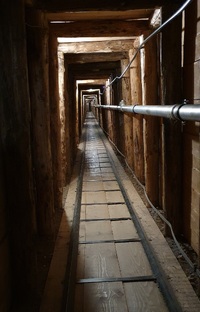Photo. The Sarajevo Tunnel. The Sarajevo Tunnel - a journey through resilience and survival. © Travel Explorations.
Arrive at the Tunnel of Hope. There I learned about the position of the museum and its famous mark in front of the entrance named "Sarajevo Rose". I was thrilled to see these significant sites and buildings in person, knowing they'd later be discussed in the museum. These were places I'd heard so much about in the news when the war first broke out. After seeing a short movie, my guide explained more about the fall of Yugoslavia, the war in Slovenia, Croatia, Bosnia, and Herzegovina, and the creation and importance of the tunnels.
This network of tunnels was built under treacherous conditions by the Bosnian Army and civilians. The tunnels were a lifeline that connected the besieged neighborhoods of Dobrinja and Butmir, running beneath the Sarajevo Airport. Experiencing the Sarajevo Tunnel was for me a journey through resilience and survival.
During the nearly four-year siege, Sarajevo's 400,000 residents faced a brutal onslaught of artillery fire, snipers, and isolation. With access to basic needs cut off-water, electricity, heating, survival demanded innovation, courage, and unity. The Sarajevo Tunnel became an indispensable passageway, allowing essential resources like food, medical supplies, and humanitarian aid to reach the city. It also provided an escape route for those seeking safety and a means for residents to return home.
Through this 800-meter tunnel, the people of Sarajevo fought for survival. Each journey through the narrow, dimly lit passage symbolized resilience in a city otherwise sealed off from the world. The tunnel served many critical functions:
- Access to Food and Water: Food scarcity was a constant threat, with rations and small community gardens barely sustaining the population. While the supplies brought through the tunnel were limited, they were life-saving, giving people enough to survive day by day.
- Medical Aid and Evacuation: Sarajevo’s hospitals, overwhelmed by war casualties, faced a dire shortage of medical supplies. The tunnel allowed for crucial supplies to be brought in and provided a way to evacuate severely injured individuals who would otherwise have had little chance of survival.
- Communication and Morale: Beyond its physical purpose, the tunnel became a lifeline to the outside world, connecting Sarajevo’s residents to the global community. It was a bridge of hope, helping them maintain morale and a sense of unity despite the war's harrowing conditions.
- Fuel for Heating and Cooking: The harsh winters made fuel vital for survival, yet it was nearly impossible to come by. Residents relied on firewood and makeshift stoves, but the limited fuel brought through the tunnel was a lifeline during freezing conditions.
- Psychological Resilience: The tunnel symbolized determination and agency for Sarajevans. It reminded them that, even in the darkest times, their efforts to survive and resist were connected to a broader cause.
Today, the Sarajevo Tunnel is preserved as a museum, honoring the city’s spirit and the courage of those who constructed it under unimaginable conditions. Visitors to the Tunnel of Hope experience not only a historical artifact but a testament to human resilience, where the people of Sarajevo defied isolation and oppression to preserve their lives and culture. The tunnel’s story serves as a timeless reminder of the strength found in unity, hope, and the will to survive.
Stein Morten Lund,
October 2024












